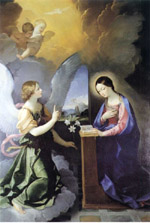|
|
Apartments in Florence, Perugia, Rome, Sorrento and Positano |




|
|
|
|
- You are in: Home » Lazio » Rome
VISIT ROME
« All the regions
FORUM ROMANUM
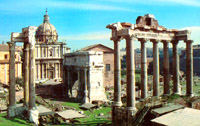
Rome has many forums. The original, the Roman Forum, lies in the valley between the Palatine and Capitoline hills (Palatino and Capitolino), on either side of the Via Sacra ("sacred way"), which still runs through it. This area was the heart of Rome for more than a thousand years, and a stone discovered under the Forum in 1899 bears an inscription from the time of the Roman kings (sixth century b.C.). The Forum has many ruins (some, like the sanctuary of the sewer goddess Venus Cloaca, are just a mark on the ground) as well as a few standing buildings. The most important is the square Curia, on the spot where the Senate once met. Although much of' what you see is a restored structure from 1937, inside the third century marble inlay floor is still visible. The Temple of Antoninus and Faustina (Antoninus Pius succeeded Hadrian in 138) was later turned into a church:, and given a baroque facade (Chiesa di San Lorenzo in Miranda). Near the Curia is the Arch of Septimius Severus, built in 203 to commemorate his victories. The arch mentioned his two sons, Caracalla and Geta, but after Caracalla murdered Geta, Geta's name was removed. At the other end of the Forum is the Arch of Titus. Titus reigned as emperor from 79 to 81.
Nearby is the hulking form of the fourth-century Basilica of Constantine and Maxentius, which occupies the site of what was Rome’s law courts. The Temple of the Dioscuri, dedicated to the twins Castor and Pollux, is immediately recognizable for its three remaining columns joined by a piece of architrave. Against the Capitoline Hill you see the Temple of Saturn, which housed the first treasury of Rome. It was also the site of the feast that was the pagan ancestor of Christmas.
top
THE TREVI FOUNTAIN
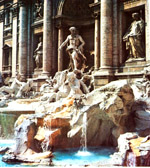
To the right of the Via del Corso, in the Via delle Muratte, is the most sumptuous fountaine in Rome: The Fontana di Trevi is not only celebrated for its excellent water but for the legend that whoever drinks it or throws a coin in the fountain, will assure his return to Rome. it is the façade of a large palace decorated with statues and bas-reliefs on heaps of rocks: the water gushes from every part. It was Agrippa who brought the Virgin Water to Rome by means of an aqueduct. The fountain was built by the architect Salvi (1735) in the time of Clement XII, and decorated by several artists of Bernini's school. It is said that the soldiers of Agrippa, looking for water in the via Collatina in the country, met a maiden who showed them the source of this pure water, which was hence called Virgin Water. The bas-relief on the right represents this event; that on the left shows Agrippa explaining to Augustus the plan to bring this water to Rome. A thorough restoration has been completed in 1991, which has given it back all its original splendour.
top
SAINT PETER
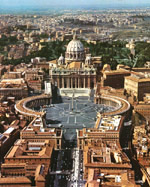
The Vatican has been the residence of the popes since 1377, only six centuries. An interrupted succession of 265 men have sat on Peter's throne, many of whom were martyrs and saints. For twenty centuries the histor of the Vatican has been the history of the world. The square is unique. It is dominated by the immense suggestive Dome, by Michelangelo. It is a harmonious poem of immensity. The dome rises gigantic against the background of the sky and its silver-blue colour merges with the same tint of the heavenly dome of which it seems the architectural synthesis. Michelangelo was already advanced in years when he began to build it, after 1546, so that at his death (1564) only the drum of the dome had been completed. The rest of the work was completed between 1588 and 1589 by Giacomo Della Porta and Domenica Fontana. Bernini was the arteficer of the impressive colonnades, wich surround the whole place, decorated with 140 statues, representing 140 different saints. In its centre stands the 25 meteres high Egyptian obelisk.
top
SPAIN SQUARE
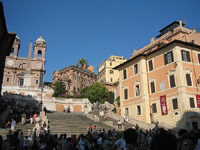
The Piazza di Spagna and the Spanish Steps (Scalinata di Spagna) rising from the piazza are the meeting place of Rome. In spring, the steps are decorated with colourful azaleas, but in any season the square is atmospheric - though you can hardly see it when it's covered with wall-to-wall tourists, lovers, backpackers, Roman youth, and so on. The atmosphere is festive and convivial, though. The piazza's name comes from the 16th century, when the Spanish ambassador made his residence here. In those days, the piazza was far less hospitable. (People passing through the piazza at night sometimes disappeared. Because it was technically Spanish territory, the unwary could be pressed-ganged into the Spanish army.) The area's most famous resident was English poet John Keats, who lived and died in the house to the right of the steps, which is now the Keats-Shelley House. The real name of the steps isn't the Spanish Steps but the Scalinata della Trinità del Monte, because they lead to the Trinità del Monte church, whose towers loom above. At the foot of the steps, the boat-shaped fountain by Pietro Bernini, father of Gian Lorenzo, is one of the most famous in Rome.
top
POPOLO SQUARE
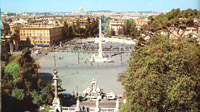
Piazza del Popolo was designed by Valadier at the turn of the century. It is an enormous square, architecturally sperb and perfectly symetrical. In the centre stands the city's second obelisk, which was brought to Rome by Augustus, and erected here by Fontana under Sictus V (1589). According the legend, in the early middle ages Nero's spirit haunted this place where his ashes had been deposited in the Domitian family's tomb. This is why the people destroyed the Mausoleum and build a church there, S. Maria del Popolo, one of the mos interesting in Rome.
top
VILLA BORGHESE
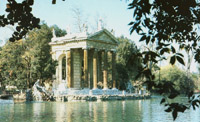
Villa Borghese is one of the loveliest gardens of Rome, a revelation of what Rome and the greatness of the nobility could do jointly, a garden not to be found elsewhere. After the election of Paul V, a Borghese, his young nephew, Scipio, was made Cardinal with a very substantial prebend. The Cardinal ordered to design this splendid Villa, a Paradise of delight, as it was called at the time. On the highest point of the Villa stands the Borghese Pavillon. It was built in 1613 by the dutch architect van Zans (Vasanzio) and restored in 1782, which is today the Borghese Museum and Gallery, offering a wide range of paintings and sculptures.
top
PANTHEON
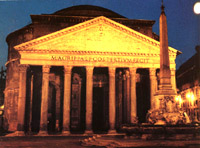
Rome's best preserved monument of antiquity, the imposing Pantheon was built by Marcus Agrippa in 27 B.C. (though later rebuilt by Hadrian) as a temple for all the gods (from the ancient Greek "pantheon," meaning "all Gods"). It was eventually saved from destruction by being transformed into a Christian church. The adjective that all descriptions of the Pantheon should contain is perfect: The building is exactly 42.6m (142 ft.) wide and 42.6m (142 ft.) tall. The portico is supported by huge granite columns, all but three of which are original, and the bronze doors weigh 20 tons each, Inside, the empty niches surrounding the space once contained marble statues of Roman gods. Animals were once sacrificed beneath the beautiful coffered dome with a 5.4m (18 ft.) hole (oculus) in the middle through which light (and sometimes rain) streams. An architectural marvel, this dome inspired Michelangelo when he was designing the dome of St. Peter's, though he made the basilica's dome .6m (2 feet) smaller. Buried here are the painter Raphael and two kings of Italy. Crowds always congregate in the square in front, Piazza della Rotonda (Piazza del Pantheon for Romans). The square contains a Giacomo della Porta fountain and many cafes though the eyesore of a McDonald's and the attendant greasy smell make the place less attractive.
top
VENEZIA SQUARE
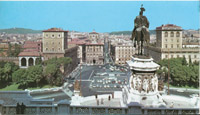
Piazza Venezia, the heart of Rome, takes its name from the Palazzo Venezia which the Venetian Paul II, a lover of munificence, had built in 1455 while he was still a cardinal. It was the first great Rennaissance palace of Eome, and it was enriched by outstanding art works. Ita was a typical example of this first Rennaissance period and it marked the transition to a modern palace from the medieval fortified dwelling place, of which it retains certain features. The Victor Emmanuel II Monument also called "Vittoriano", was designed by Giuseppe Sacconi (1885-1911). It rises at the foot of the Capitol in the heart of Rome, where it was squeezed in, altering the ancient relationship between this hill and the neighbouring district, with its massive dimension. The building's two colossal wings are surmounted by winged victories, whose dark bronze contrasting with the bright marble and clearly visible against the panorama of Rome, were made in 1908 by Carlo Fontana and Paolo Bartolini.
top
NAVONA SQUARE
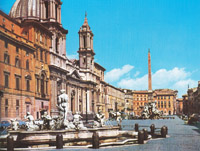
The Piazza Navona, or Circo Agonale, occupies the place of the Stadium of Domitian, that could hold 30'000 spectators. Here are three magnificent fountains. The one in the centre, "an Aesop's fable fashioned in marble" is the Fountain of the Four Rivers by Bernini, who made it as a base for the Egyptian obelisk brought here from the Circus Maxentius. It contains four statues which represent the Danube, the Ganges, the Nile and the Rio de la Plata. The church of S. Agnese in Agone, is built on the spot where, according to tradition, the virgin, denuded before her martyrdom, was mantled in her hair, which had grown miraculosly to cover her. It is a magnificent baroque building designed by G. Rainaldi and Borromini.
top
COLOSSEUM
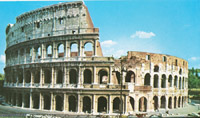
At the end of the Via dei Fiori Imperiali stands the Colosseum, one of the greatest marvels of the Roman Civilization. This immense amphitheatre, whose ancient splendour we can still admire, was begun by Vespasian in A.D. 72 and finished by his son Titus in A.D. 80. Hebrew prisoners were employed in its construction. Its real name is the Flavian Amphitheatre, commonly called Colosseum. After the sacking of the Normans (1084), nothing but a skeleton remained of antique classic Rome; the Colosseum was abandoned and for years it was used as a quarry for building material. The Colosseum, of elliptical form, is 205 yards in its longest diameter and 170 yards in its shortest. On the outside there were three rows of arhes, respectively adorned with Doric, Ionic and Corinthian columns, an a fourth floor was adorned with Corinthian pilasters. An ellipse of 80 arches formed the other circuit. When the amphiteatre was at the climax of its glory, it must have been a stupendous sight of Roman splendour. But even today, after so many centuries, the Colosseum is the pride of Rome and the marvel of visitors.
top
|
|
|
|
|
|
| TOP DESTINATIONS
|
| Adria Coast, Aeolian Islands, Alessandria, Altopiano Delle Rocche, Amalfi Coast, Aosta, Assisi, Asti, Bari, Brescia, Capo Vaticano, Capri, Catanzaro, Chianti, Cilento, Cinque Terre, Coast Of Marche, Conero Coast, Dolomites, Egadi Islands, Elba, Florence, Garda Lake, Gargano, Ischia, Italian Riviera, Lake Como , Langhe Piedmont, Lecce, Lucca, Lunigiana, Macerata, Mantova, Maremma Tuscany, Monferrato, Montepulciano, Naples, Perugia, Pesaro Urbino, Pisa, Pistoia, Positano, Prato, Procida, Riviera Of Palms, Rome, Salento Coast, Salerno, San Gimignano, Sardinia, Sicily, Siena, Sorrento, Terni, Tiber Valley Of Tuscany, Treviso, Turin, Val Gandino, Veneto, Venice, Viterbo |
|
|













